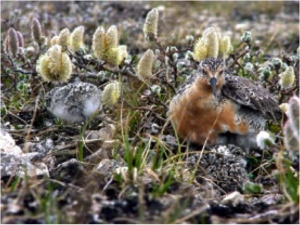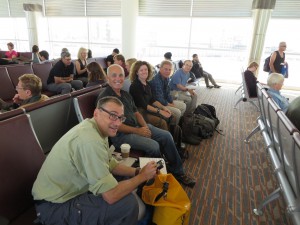Update from the Arctic: News from Our Shorebird Scientists
CWF’s Larry Niles and his colleagues left yesterday on a three-week trip to Northern Canada to search for the nests of Red Knots and other shorebirds in their Arctic breeding territory. We’ll be following him and posting summaries of his blog entries as he reports from the field.

The odd thing about the shorebirds of Delaware Bay is that they are not really of Delaware Bay but of the Canadian Arctic. The most important part of their lives is spent in the barren high tundra of the Arctic, in places like Southampton Island, located on the north end of Hudson Bay. We have worked in Southampton Island for 6 years studying the red knot but stopped because the decline seen in Delaware Bay was more than apparent in the Arctic – birds literally disappeared from our study site.

It’s been 8 years since then, and now we are returning to begin new research on red knots. The first job of our small team (Larry Niles of the Conserve Wildlife Foundation of New Jersey, Mark Peck of the Royal Ontario Museum, Rick Lathrop of Rutgers University, Amanda Dey on vacation from NJ Division of Fish and Wildlife, and Steve Gates) will be to catch adult birds and attach geolocators, including a new type with a small radio transmitter to help relocate the bird next year. These small devices allow us to track birds around the globe. Our second job is to finish work started years ago on developing an Arctic-wide habitat map for red knots. These two projects are interrelated. Relocated knots help us determine the important places that define red knots habitat. We started this work in our first year.

In 2000, Mark Peck and I hatched a plan to search for knots with transmitters that we attached while the birds stopped over on Delaware Bay. We were foolish enough to think that we could follow the birds to the Arctic and relocate them from an airplane. We didn’t really grasp the odds of success. The transmitters had a range of 8 miles, and we would have to search an area the size of the eastern US. Our anxiety grew when we found that with the cost of renting a plane in the Arctic, we could afford only a few days of searching. As it turned out, we only needed one. Lucky for us, we flew Southampton Island and to our surprise found 8 birds with transmitters. We spent the rest of our time on the ground searching and eventually found the first nest of rufa knots.

Over the years our experience has grown but the knot population has shrunk, making them more difficult to find. Knots are tough to find anyway. They occur in very low densities (usually less than one per square kilometer) and the non-incubating adult doesn’t defend the territory, which is the usual clue that a shorebird is nesting nearby. Knots rarely nest where other shorebirds nest, choosing instead to lay eggs in barren tundra far from the coast. We hope to improve our chances this year by going later than normal and searching for adults with broods instead of nests.
For the full blog entry, see Larry’s post here.
Stay tuned for further updates!
Discover more from Conserve Wildlife Foundation of NJ
Subscribe to get the latest posts sent to your email.
Leave a Comment
Good luck Larry to you and the team !
Comments are closed.